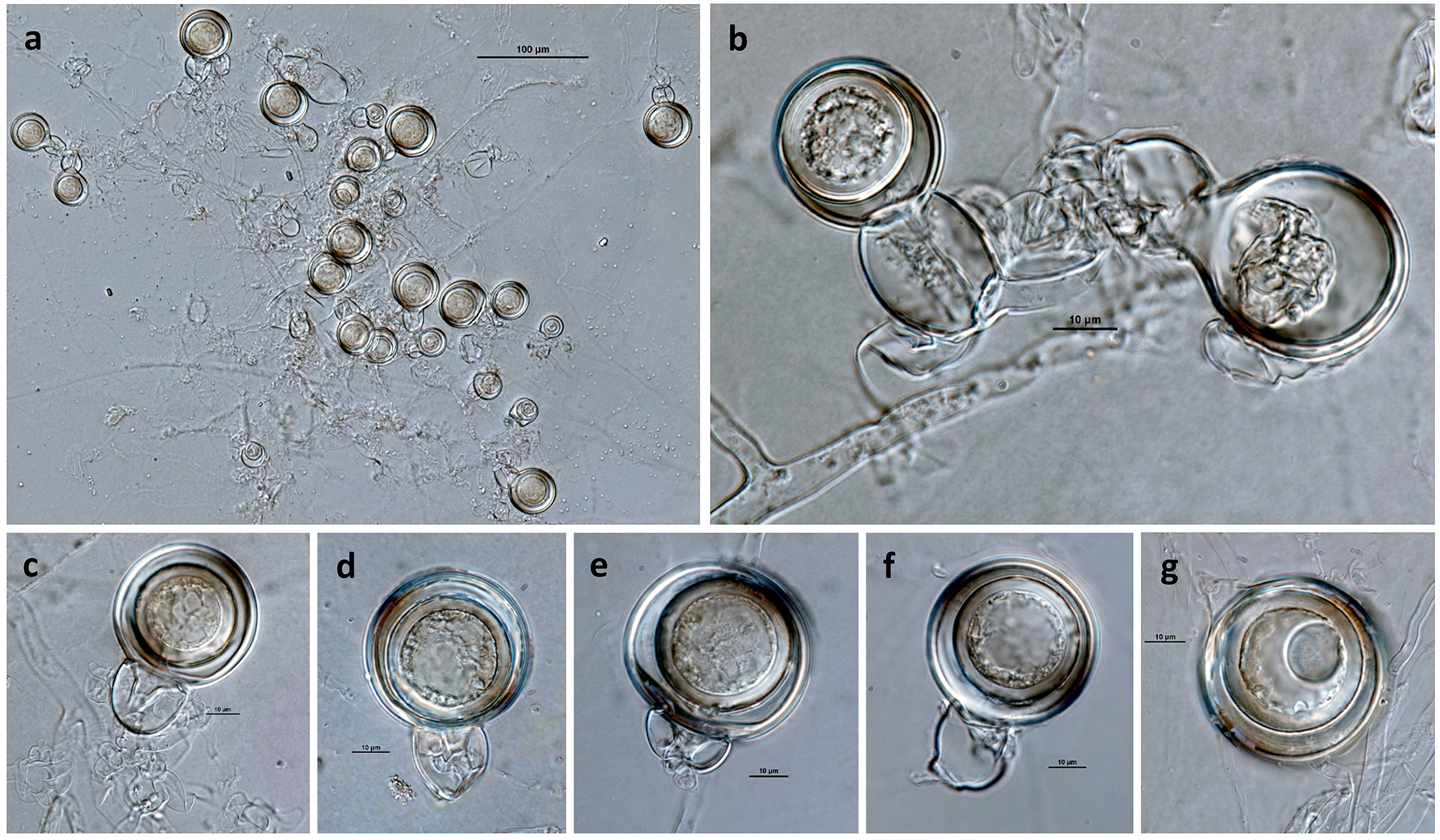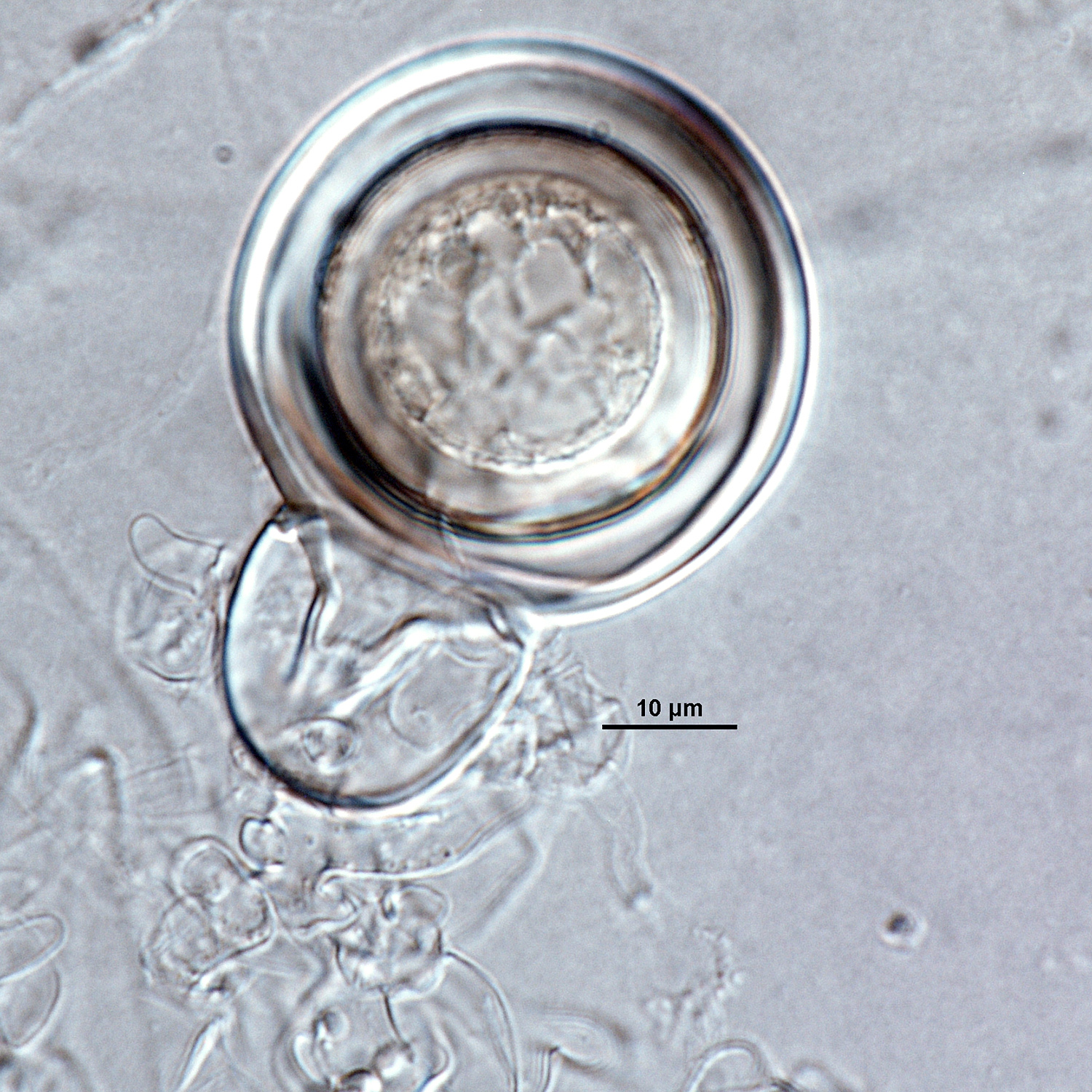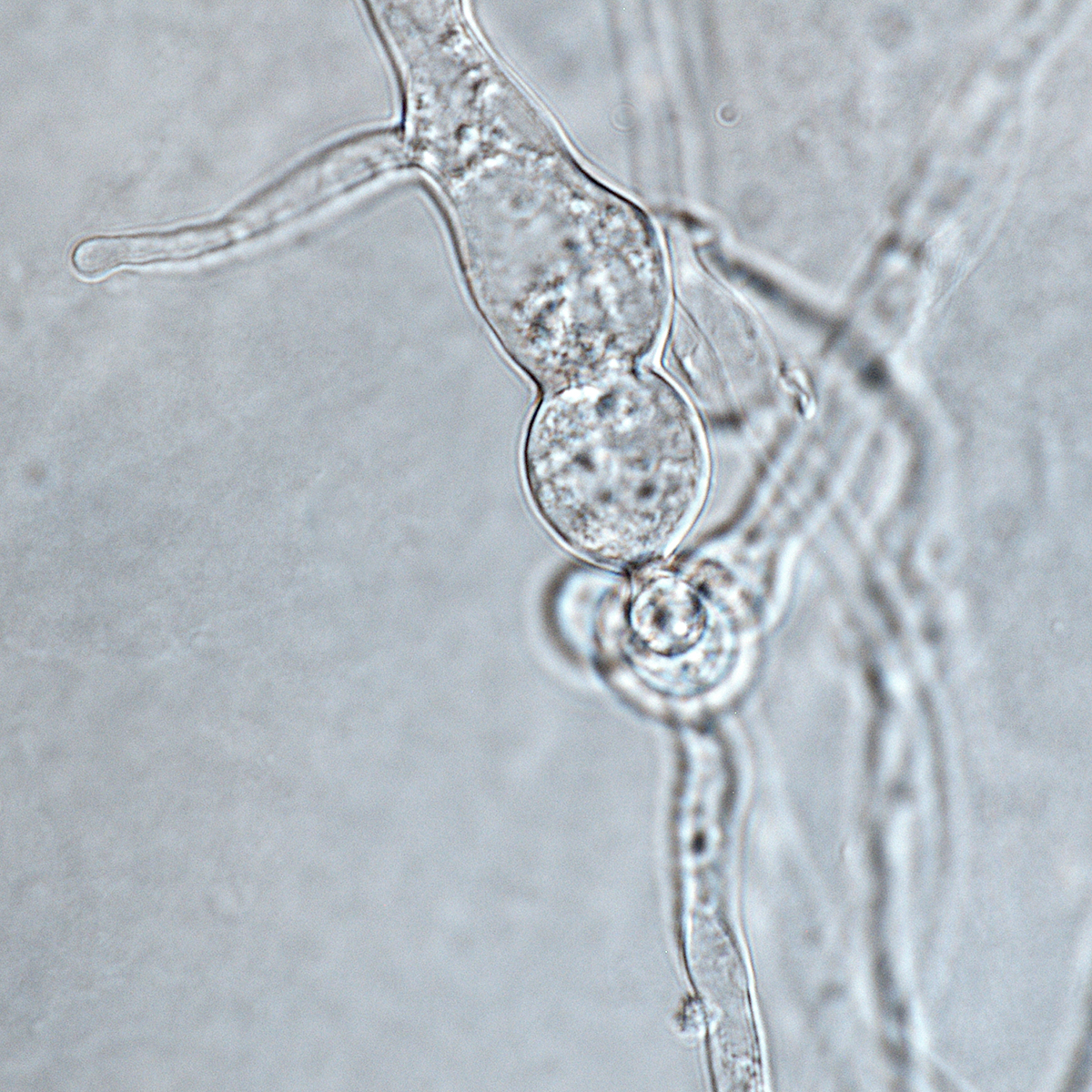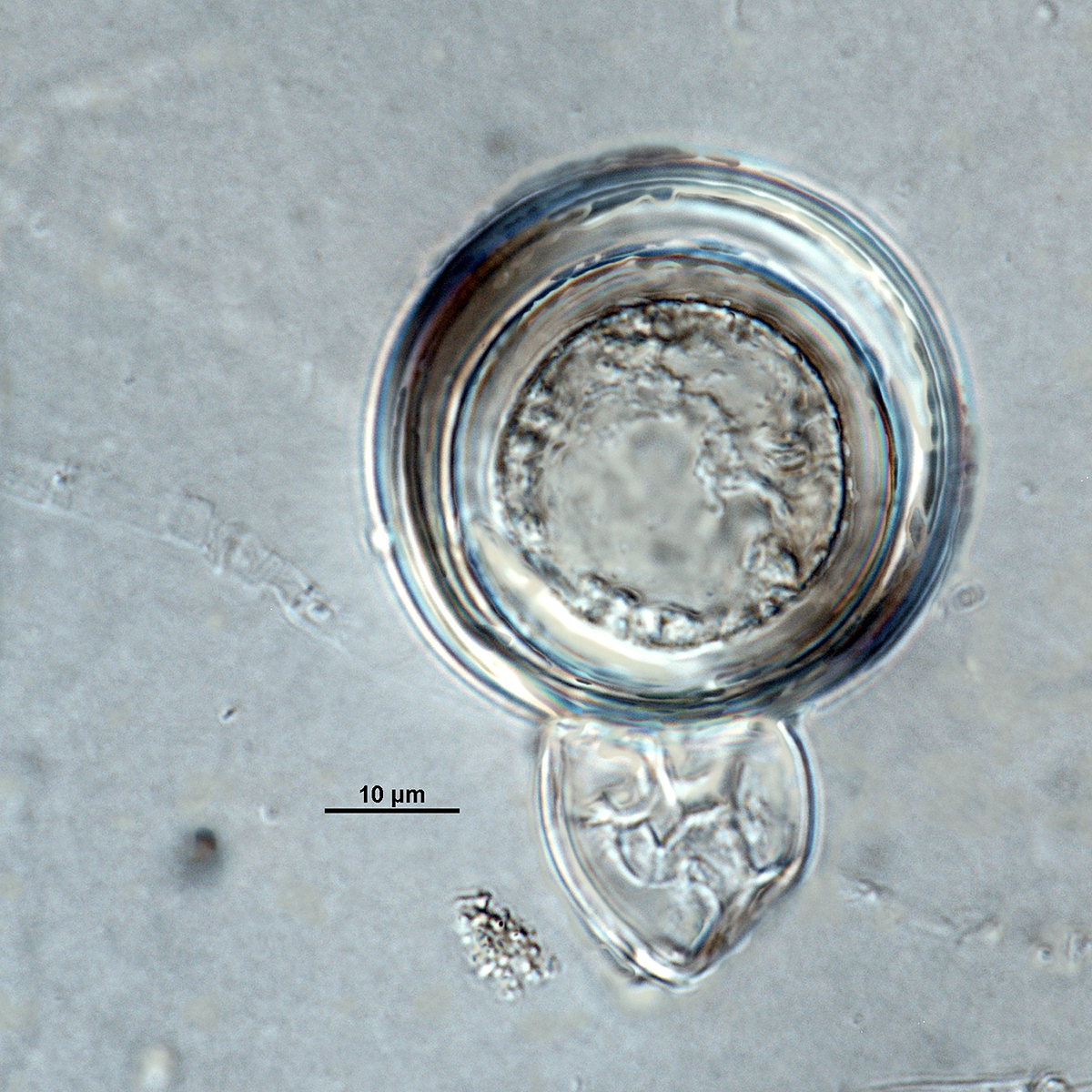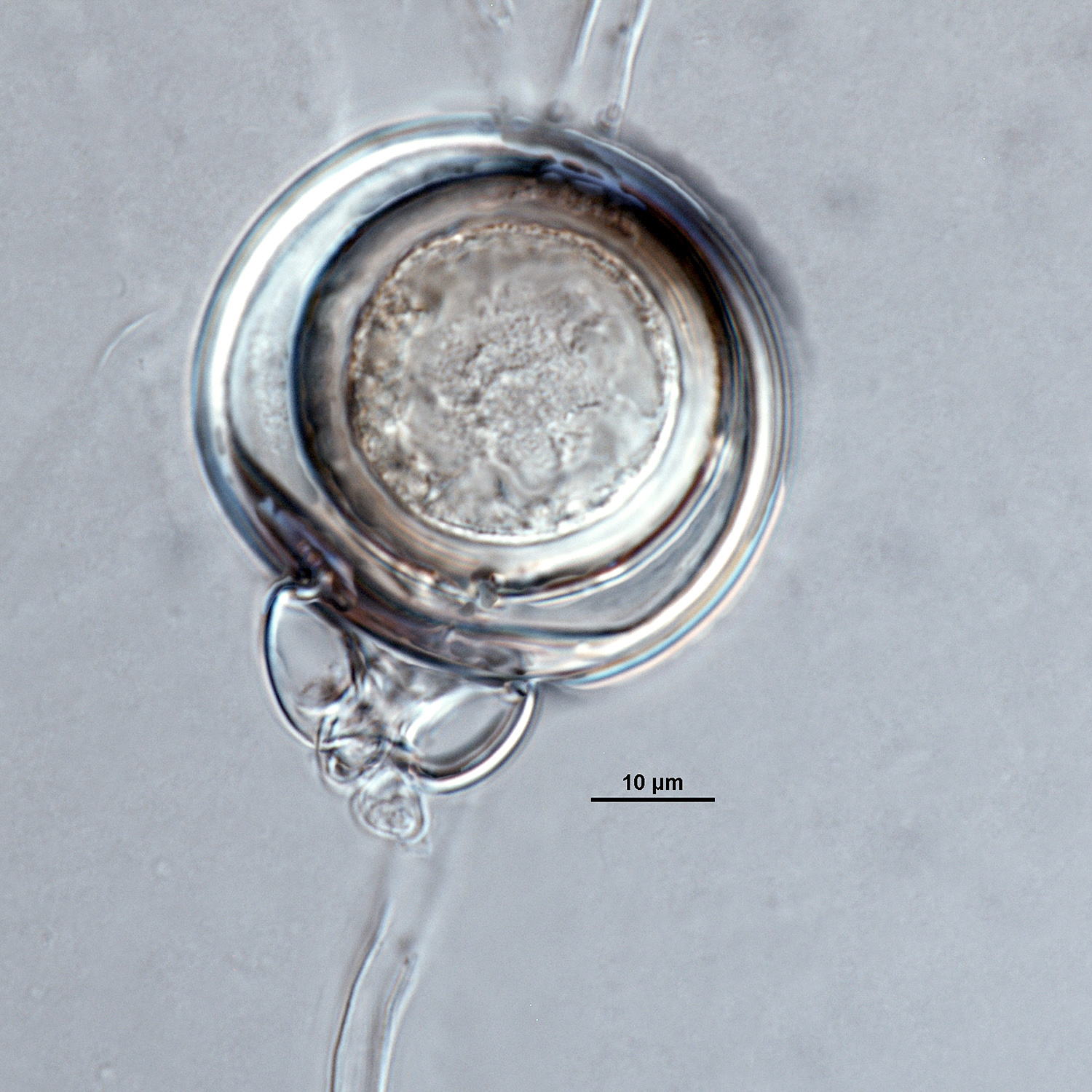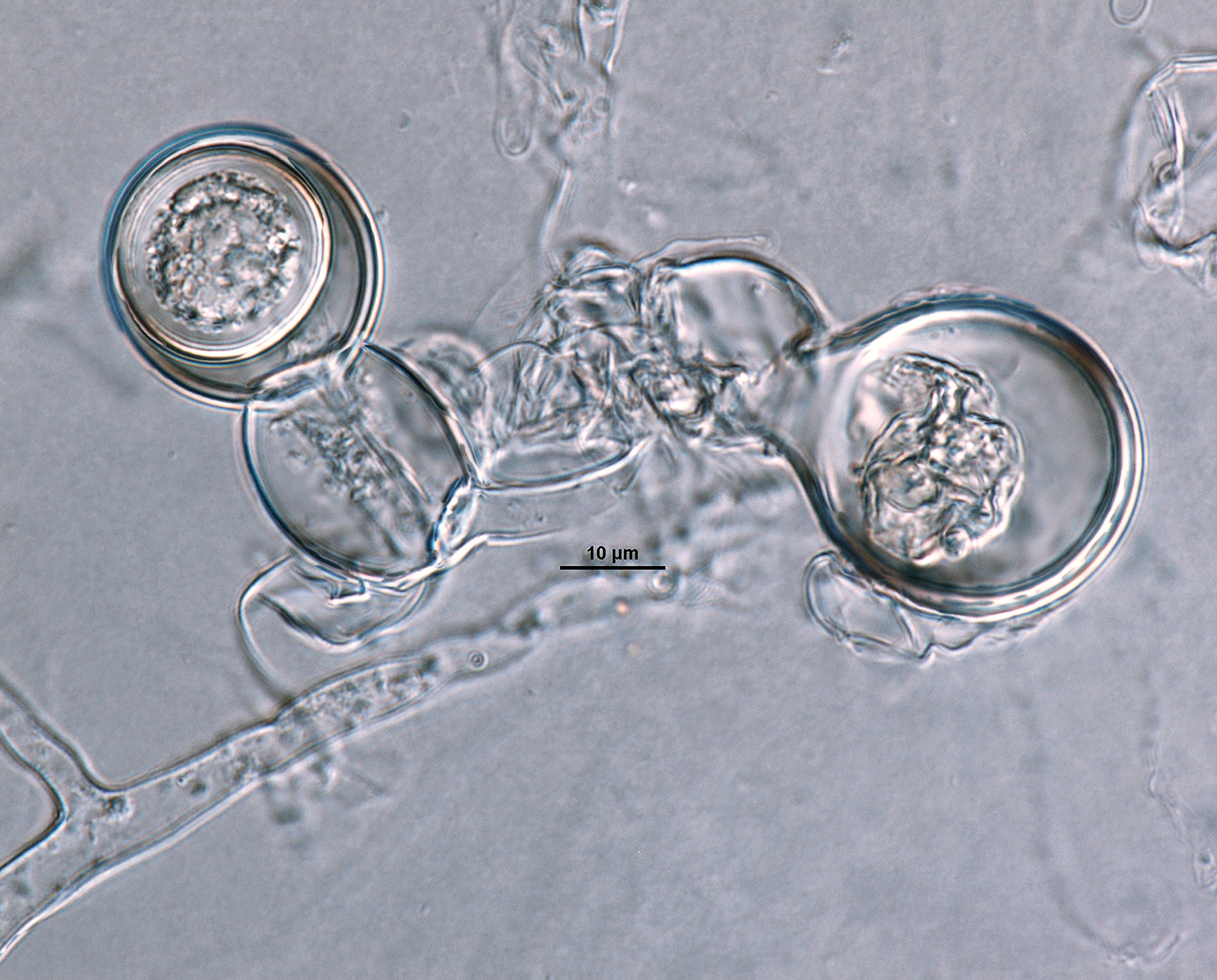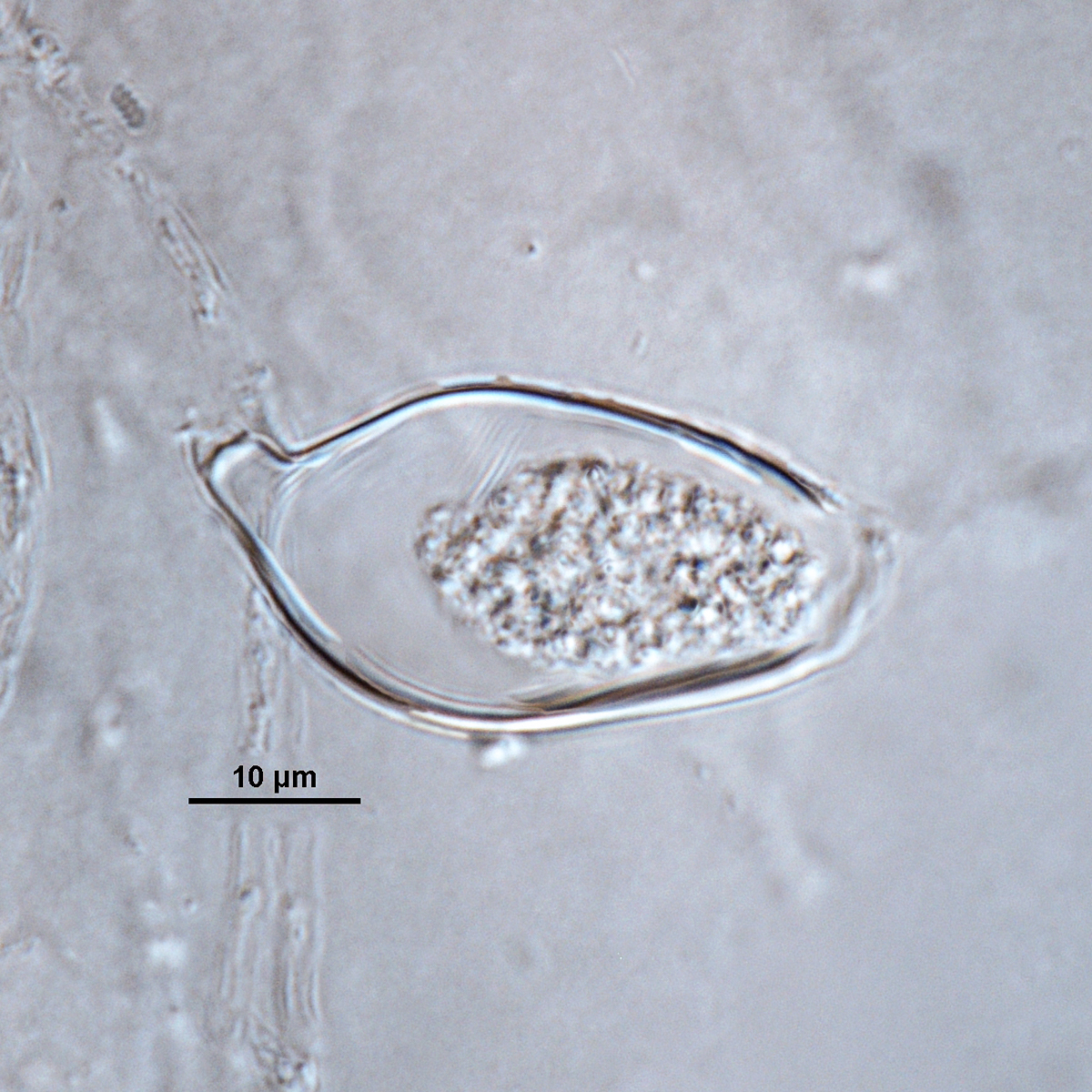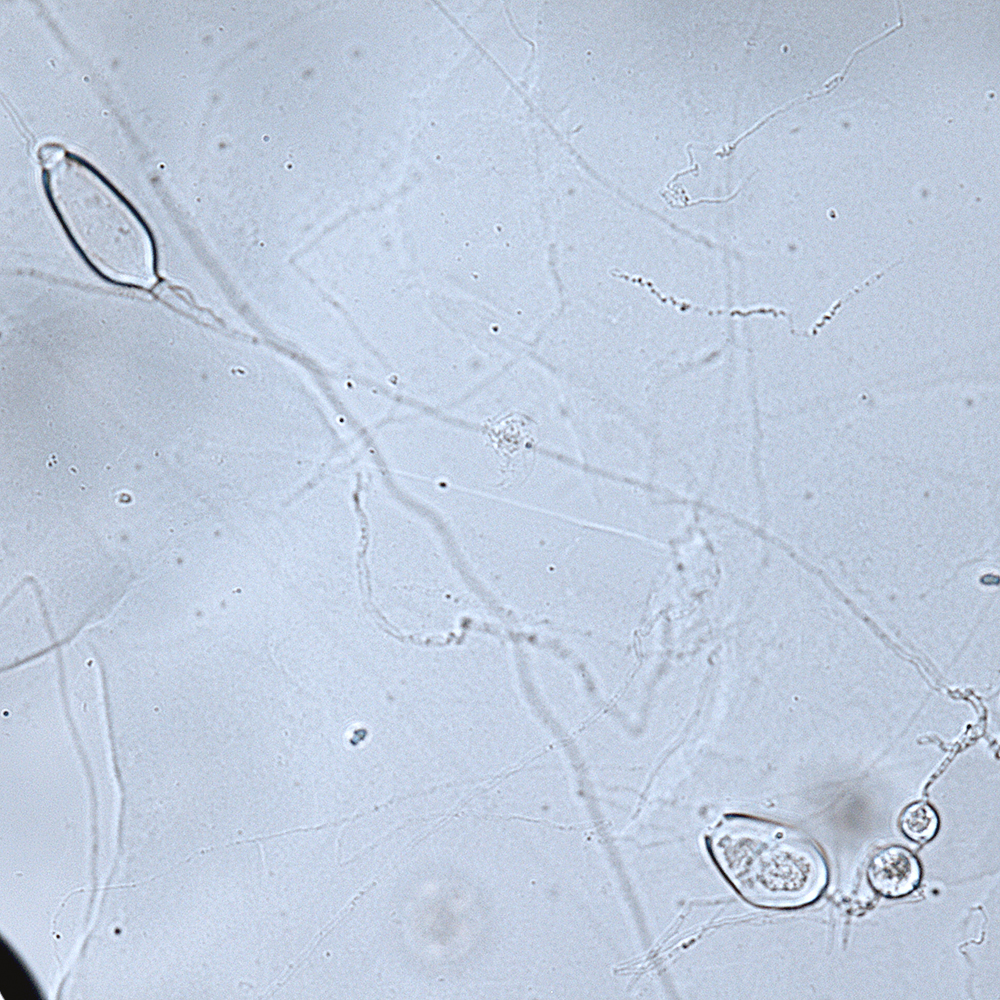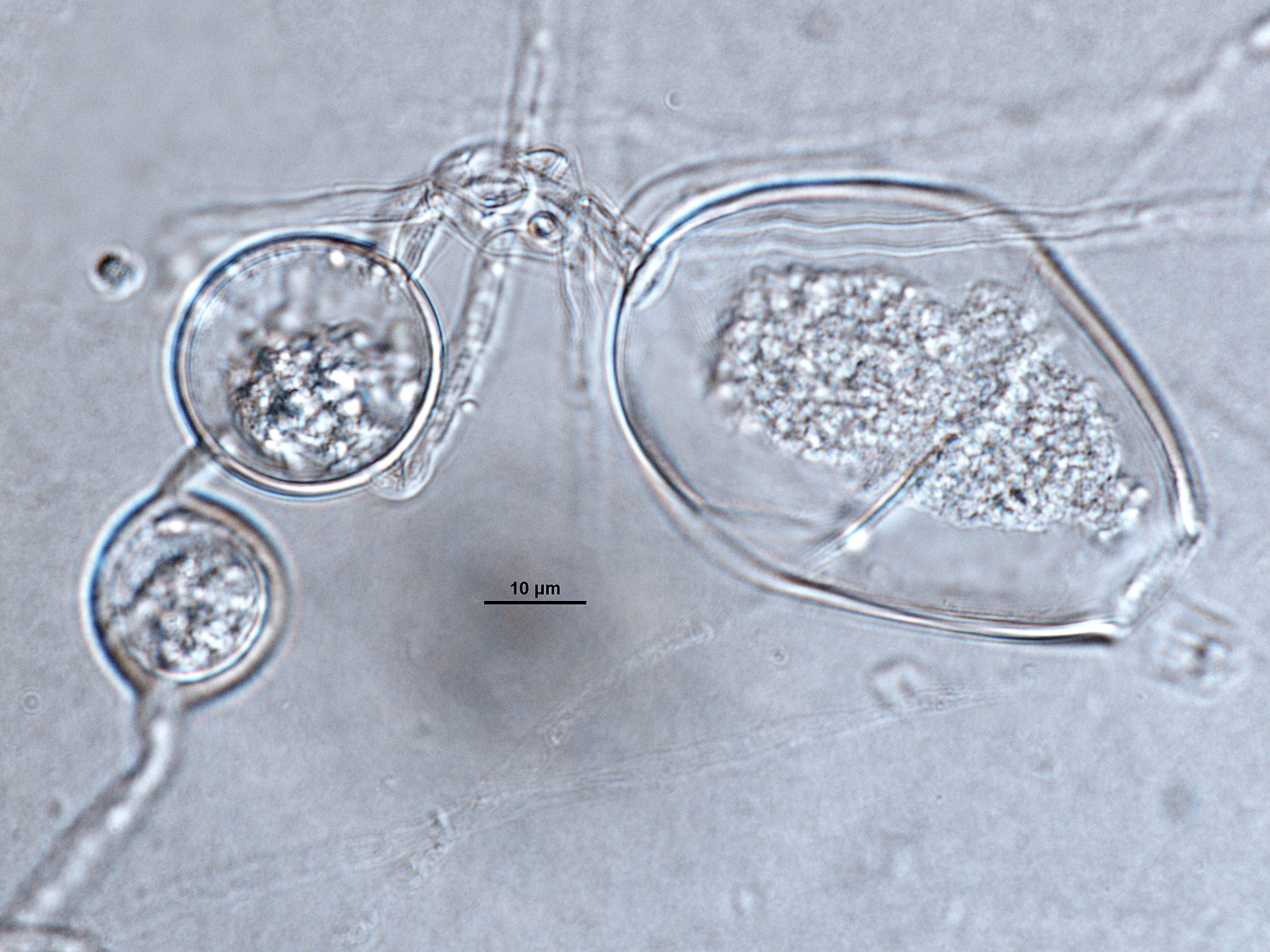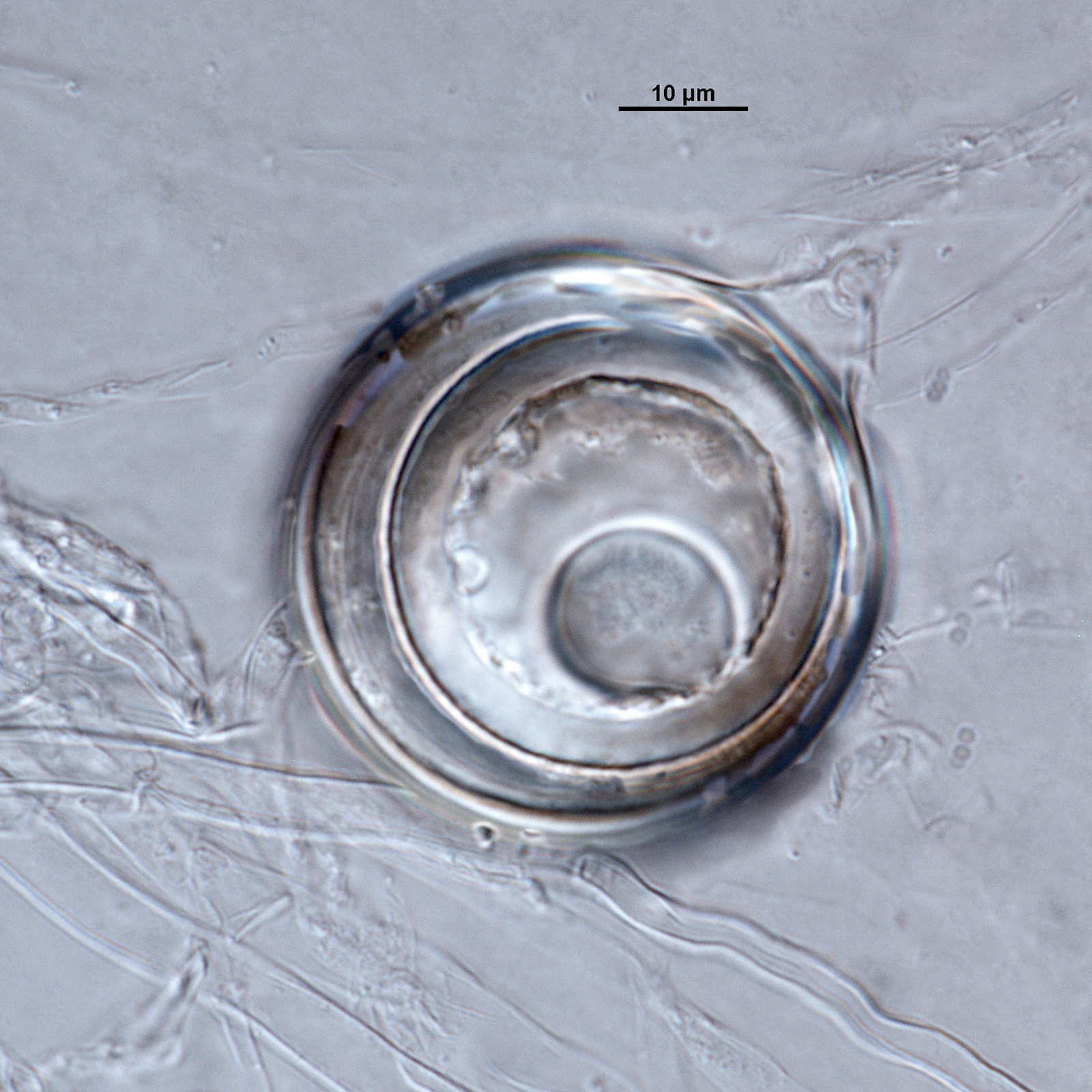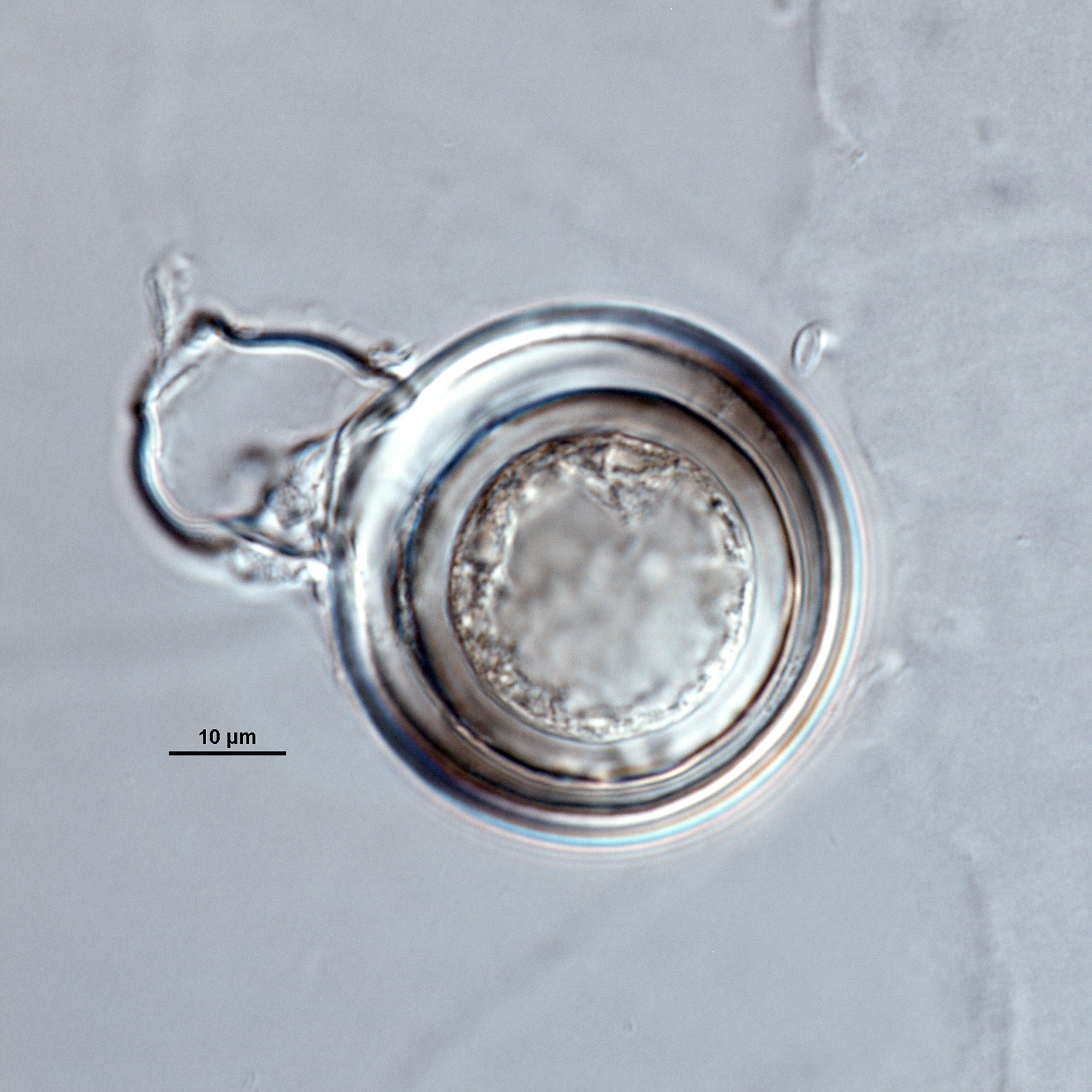Phytophthora pisi (in progress - Abad et al. 2023b)
|
Phytophthora spp. in subclade 7b: portion of the seven-loci ML phylogeny featuring the type cultures of 212 described species (by T. Bourret). Notice the position of P. pisi selected specimen CBS 130350 = S&T BL 133. Gloria Abad, USDA S&T.
|
|
Phytophthora spp. in subclade 7b: Morphological Tabular key (PDF) and Tabular key legends (PDF) in IDphy2 KEY SECTION. Notice the data of P. pisi selected specimen CBS 130350 = S&T BL 133. Gloria Abad, USDA S&T.
|
|
Phytophthora pisi (CPHST BL 133) colonies of the ex-type grown for 7 days on (a) V8® Agar, (b) potato dextrose agar, and (c) malt extract agar; photo by Krysta Jennings and Leandra Knight, USDA-APHIS-PPQ |
|
Phytophthora pisi (ex-type CPHST BL 133) asexual phase: (a, b, d) semipapillated sporangia, (c) hyphal swellings, (d, e) sporangia with hyphal swellings; photos by Gloria Abad, USDA-APHIS-PPQ. |
|
Phytophthora pisi (ex-type CPHST BL 133) sexual phase (a–g): (a) abundant feature bodies produced in agar media, (b–e) smooth-walled oogonia with amphigynous antheridia and aplerotic oospores, (f) large-lobed amphigynous antheridium, (g) evanescent-lobed amphigynous antheridium; photos by Gloria Abad, USDA-APHIS-PPQ. |
|
Phytophthora pisi (ex-type CPHST BL 133) sexual phase: smooth-walled oogonium with amphigynous antheridium and aplerotic oospore; photo by Gloria Abad, USDA-APHIS-PPQ. |
|
Phytophthora pisi (ex-type CPHST BL 133) asexual phase: hyphal swellings; photo by Gloria Abad, USDA-APHIS-PPQ. |
|
Phytophthora pisi (ex-type CPHST BL 133) sexual phase: abundant oospore production in agar media; photo by Gloria Abad, USDA-APHIS-PPQ. |
|
Phytophthora pisi (ex-type CPHST BL 133) sexual phase: smooth-walled oogonium with amphigynous antheridium and aplerotic oospore; photo by Gloria Abad, USDA-APHIS-PPQ. |
|
Phytophthora pisi (ex-type CPHST BL 133) sexual phase: smooth-walled oogonium with amphigynous antheridium and aplerotic oospore; photo by Gloria Abad, USDA-APHIS-PPQ. |
|
Phytophthora pisi (ex-type CPHST BL 133) sexual phase: smooth-walled oogonia with amphigynous antheridia and aplerotic oospores; photo by Gloria Abad, USDA-APHIS-PPQ. |
|
Phytophthora pisi (ex-type CPHST BL 133) asexual phase: semipapillated sporangium; photo by Gloria Abad, USDA-APHIS-PPQ. |
|
Phytophthora pisi (ex-type CPHST BL 133) asexual phase: semipapillated sporangia and hyphal swellings; photo by Gloria Abad, USDA-APHIS-PPQ. |
|
Phytophthora pisi (ex-type CPHST BL 133) asexual phase: semipapillated sporangium and hyphal swellings; photo by Gloria Abad, USDA-APHIS-PPQ. |
|
Phytophthora pisi (ex-type CPHST BL 133) sexual phase: evanescent-lobed amphigynous antheridium and aplerotic oospore; photo by Gloria Abad, USDA-APHIS-PPQ. |
|
Phytophthora pisi (ex-type CPHST BL 133) asexual phase: semipapillated sporangium; photo by Gloria Abad, USDA-APHIS-PPQ. |
|
Phytophthora pisi (ex-type CPHST BL 133) sexual phase: large-lobed amphigynous antheridium and aplerotic oospore; photo by Gloria Abad, USDA-APHIS-PPQ. |
Name and publication
Phytophthora pisi Heyman (2013)
Phytophthora pisi Heyman ex Abad sp. nov. (2023)
Heyman F, Blair JE, Persson L, and Wikström M. 2013. Root rot of pea and faba bean in southern Sweden caused by Phytophthora pisi sp. nov. Plant Dis. 97: 461–471.
Corresponding author: F. Heyman fredrik.heyman@slu.se
Nomenclature
from Heyman et al. (2013)
Mycobank
Etymology
“Pisi” refers to the host plant pea, from which it was first isolated.
Typification
Type: SWEDEN, Skåne Län, Höganäs, isolated from roots of Pisum sativus, by M. Wikström in 1997; 97603 (?)
Ex-type: CBS 130350 and P19612 World Oomycete Collection
Selected specimen in other collections
(SE) CBS 130350, WPC P19612, S&T BL 133 (Abad)
Molecular identification
Voucher sequences for barcoding genes (ITS rDNA and COI) of the selected specimen (see Molecular protocols page)
Phytophthora pisi isolate CPHST BL 133 (= P19612) ITS rDNA MG865567, COI MH477754
Voucher sequences for Molecular Toolbox with seven genes (ITS, β-tub, COI, EF1α, HSP90, L10, and YPT1
(see Molecular protocols page) (In Progress)
Voucher sequences for Metabarcoding High-throughput Sequencing (HTS) Technologies [Molecular Operational Taxonomic Unit (MOTU)]
(see Molecular protocols page) (In Progress)
Sequences with multiple genes for selected specimen in other sources
- NCBI: Phytophthora pisi CPHST BL 133
- NCBI: Phytophthora pisi 97603
- NCBI: Phytophthora pisi CBS 130350
- EPPO-Q-bank: Phytophthora pisi
- BOLDSYSTEMS: Phytophthora pisi (barcoding COI & ITS)
Position in multigenic phylogeny with 7 genes (ITS, β-tub, COI, EF1α, HSP90, L10, and YPT1)
Clade clade:
a taxonomic group of organisms classified together on the basis of homologous features traced to a common ancestor
7b
Morphological identification
adapted from Heyman et al. (2013)
Colonies and cardinal temperatures
Colony colony:
assemblage of hyphae which usually develops form a single source and grows in a coordinated way
morphology on V-8 agar, potato dextrose agar, and malt extract agar with no distinctive pattern and slow growth. Minimum temperature for growth 4°C, optimum 25–30°C, maximum 37°C.
Conditions for growth and sporulation
Sporangia and hyphal swellings produced in liquid media, and gametangiagametangia:
part of hypha specialized for fusion in sexual reproduction (see antheridium and oogonium)
readily produced on culture media after 4 days.
Asexual phase
Sporangia nonpapillate; persistentpersistent:
pertaining to sporangia that remain attached to the sporangiophore and do not separate or detach easily (cf. caducous)
; ovoidovoid:
egg-shaped, with the widest part at the base of the sporangium and the narrow part at the apex
or ellipsoidellipsoid:
refers to a solid body that forms an ellipse in the longitudinal plane and a circle in cross section; many fungal spores are ellipsoidal or elliptic
(31–160 L x 17–45 W µm); showing occasionally internal nested or external proliferationexternal proliferation:
formation of a sporangium after a sporangiophore has emerged from beneath and external to an empty sporangium that has previously emitted its zoospores (cf. internal proliferation)
and originated in unbranched or closely sympodial sporangiophores. Hyphal swellings globoseglobose:
having a rounded form resembling that of a sphere
and intercalaryintercalary:
positioned within a hypha (cf. terminal)
, formed in liquid cultures. ChlamydosporesChlamydospores:
an asexual spore with a thickened inner wall that is delimited from the mycelium by a septum; may be terminal or intercalary, and survives for long periods in soil
absent.
Sexual phase
Homothallic. OogoniaOogonia:
the female gametangium in which the oospore forms after fertilization by the antheridium
smooth-walled, globoseglobose:
having a rounded form resembling that of a sphere
(24–47 µm diam.); antheridia amphigynous; oosporesoospores:
zygote or thick-walled spore that forms within the oogonium after fertilization by the antheridium; may be long-lived
apleroticaplerotic:
pertaining to a mature oospore that does not fill the oogonium; i.e. there is room left between the oospore wall and oogonium wall (cf. plerotic)
(19–35 µm diam.).
Most typical characters
Phytophthora pisi is characterized by the presence of nonpapillatenonpapillate:
pertaining to the production of a non-distinct, or inconspicuous, papilla at the distal end of the sporangium (cf. papillate and semipapillate)
sporangia and homothallichomothallic:
pertaining to sexual reproduction that can take place within a single thallus (i.e. self-fertile, non-outcrossing) (cf. heterothallic).
oogonia with apleroticaplerotic:
pertaining to a mature oospore that does not fill the oogonium; i.e. there is room left between the oospore wall and oogonium wall (cf. plerotic)
oospores.
Additional specimen(s) evaluated
Phytophthora pisi ex-type CPHST BL 133, duplicate of P19612 (World Phytophthora Collection)
Hosts and distribution
Distribution: Europe (Sweden)
Substrate: roots
Host: Pisum sativum (Fabaceae)
Retrieved February 01, 2018 from U.S. National Fungus Collections Nomenclature Database.
Additional references and links
- SMML USDA-ARS: Phytophthora pisi
- EPPO Global Database: Phytophthora pisi
- Forest Phytophthora of the world: Phytophthora pisi
- CABI Digital Library: Phytophthora pisi
- Encyclopedia of Life (EOL): Phytophthora pisi
- Index Fungorum (IF): Phytophthora pisi
- Google All Phytophthora pisi
- Google Images Phytophthora pisi
- Google Scholar Phytophthora pisi
Fact sheet author
Z. Gloria Abad, Ph.D., USDA-APHIS-PPQ-S&T Plant Pathogen Confirmatory Diagnostics Laboratory (PPCDL), United States of America.



